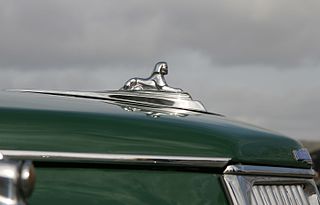
The Triumph Herald is a small two-door car introduced by Standard-Triumph of Coventry in 1959 and made through to 1971. The body design was by the Italian stylist Giovanni Michelotti, and the car was offered in saloon, convertible, coupé, estate and van models, with the latter marketed as the Triumph Courier.

The Singer Gazelle name has been applied to two generations of motor cars from the British manufacturer Singer. It was positioned between the basic Hillman range and the more sporting Sunbeam versions.

The Humber Sceptre is an automobile which was produced in the United Kingdom from 1963 to 1976 by Humber.

The Armstrong Siddeley Sapphire is a large automobile which was produced by the British company, Armstrong Siddeley Motors Limited, from 1952 to 1960.

The MG D-type "Midget" is a sports car that was produced by MG in 1931 and 1932. It used the engine from the MG M-type in the chassis from the MG C-type and was only available as a four-seater. Of the 250 cars produced, 208 were open tourers, 37 were salonettes and five went to external coachbuilders.
The MG K-type Magnette is a motor car produced in the United Kingdom by MG from October 1932 to 1934.

The MG L-type is a sports car that was produced by the MG Car company in 1933 and 1934.

The Rover Sixty and Rover Seventy-Five or Rover P3 series were 1.6 and 2.0-litre executive cars announced in the middle of February 1948 and produced by the Rover Company until the summer of 1949. Two months after the announcement of the new cars "a new vehicle for agriculture" was announced, the Land Rover, with the engine of the new Sixty.

The Singer Bantam is a car which was produced by Singer from 1936 to 1939. It was the first model from Singer to have an all-steel body, by Pressed Steel Company. It was offered as a new economy model at the 1935 Motor Show in London, replacing the earlier Singer Nine series.

The Standard Vanguard is a car which was produced by the Standard Motor Company in Coventry, England, from 1947 until 1963.

The Morris Ten announced 1 September 1932 is a medium-sized car introduced for 1933 as the company's offering in the important 10 hp sector of the British market. It continued through a series of variants until October 1948 when along with Morris's Twelve and Fourteen it was replaced by the 13.5 hp Morris Oxford MO.

The Singer Roadster is a nine tax horsepower open 2/4-seater sports-tourer automobile manufactured by Singer from 1939 until 1955. It was launched in March 1939 as an open version of Singer's Bantam saloon and using many Bantam parts.

The Triumph Renown is strictly the name given to the Triumph's large saloon car made from 1949 to 1954 but it is, in reality, part of a three-car series of the 1800, 2000 and Renown models. Together with the Triumph Roadster, they were the first vehicles to carry the Triumph badge following the company's takeover by the Standard Motor Company.

The MG M-type is a sports car that was produced by the MG Cars from April 1929 until 1932. It was sometimes referred to as the 8/33. Launched at the 1928 London Motor Show when the sales of the larger MG saloons was faltering because of the economic climate, the small car brought MG ownership to a new sector of the market and probably saved the company. Early cars were made in the Cowley factory, but from 1930 production had transferred to Abingdon.

The Rover 12 was a name given to several medium-sized family cars from the British Rover car company between 1905 and 1948.

The Daimler DB18 is an automobile produced by Daimler from 1939 until 1953. It is a 2½-litre version of the preceding 2.2-litre New Fifteen introduced in 1937. From 1949, the DB18 was revised to become the Daimler Consort.

The Lanchester Ten and Lanchester Eleven were sold by The Lanchester Motor Company Limited from the Ten's announcement in September 1932 until 1951. Quite different from previous Lanchesters, the Ten was the second of Lanchester's new owner's new Daimler-linked Lanchester range. The names Ten and Eleven referred to the engine's rating for the annual tax and did not relate to the engine's power output.

The Vauxhall 14-6 is an automobile produced by Vauxhall in the United Kingdom from 1939 until 1948.

The Singer Nine is a car which was produced by Singer Motors Limited from February 1933 to 1937, and then again from 1939 until 1949 as a Roadster only. It was offered as a new economy model, replacing the earlier Singer Junior series. The "Nine" engine was briefly fitted inside the body of the earlier Junior as a solution to production problems in 1932. The hybrids are known as the "Junior Nine" and are recognisable by the cursive "Nine" badge adorning the radiator stone-guard.
The Singer Twelve name was used for several automobiles produced by Singer Motors. The "Twelve" in the name referred to the taxation horsepower rating in the United Kingdom.




















